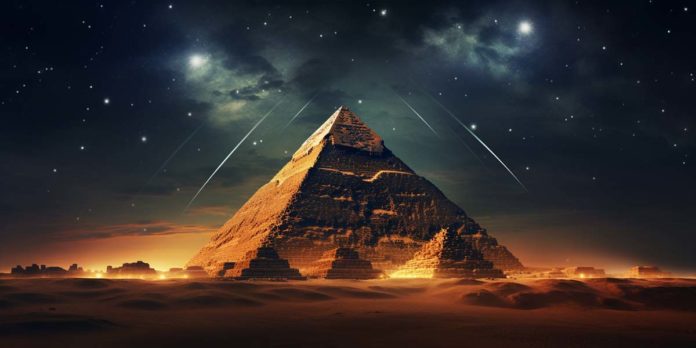In the sandy silence of the Giza Plateau, the majestic pyramids stand as timeless testaments to ancient Egypt’s grandeur. Among the many mysteries these stone colossi guard, one has persistently captivated scholars and enthusiasts alike: Are the pyramids a cosmic blueprint, mirroring the stars of Orion’s Belt? This enigmatic question harks back to a theory that may intertwine the heavens with these earthly monuments.
According to Astronomy, the Orion Correlation Theory, introduced by researcher Robert Bauval in the 1980s, posits a celestial connection between the Giza pyramids and the constellation Orion.
Bauval’s groundbreaking proposition, which gained mainstream attention through his 1995 bestseller, “The Orion Mystery,” suggests that the pyramids were meticulously aligned with the stars, serving as a gateway to the stars and reflecting ancient Egyptian cosmology.
Critics, however, raise eyebrows at the Orion Correlation Theory, citing a lack of concrete evidence and Egyptian textual references to support the celestial blueprint claim. Despite this, the theory’s allure remains undiminished, as it taps into the human penchant for finding patterns and meanings—even potentially among the stars.
Connection with The Father of The Gods
The intrigue deepened with the discovery of narrow ‘star shafts’ within the Great Pyramid. Initially thought to be air shafts, some Egyptologists proposed that these conduits were meant to direct the pharaoh’s soul to the imperishable stars, specifically to Orion, which was associated with Sah, the father of the gods.
While these shafts are not precisely aligned for direct observation, their symbolic significance is hard to dismiss, given the Egyptians’ deep-seated stellar beliefs.
The recent technological forays into the pyramid’s inner sanctums by Leeds University researchers have only magnified the enigma. A robot navigated the shafts, revealing a chamber adorned with symbols, hinting at a purpose beyond mere ventilation. This tantalizing discovery suggests that the pyramids’ architects may have imbued these structures with profound spiritual or celestial functions.
Beyond the shafts, there are subtle yet compelling alignments to ponder. The pyramids’ corners align closely with the cardinal directions, and the winter solstice sunset falls over the Pyramid of Menkaure when viewed from the Great Sphinx. These celestial connections showcase the ancient Egyptians’ sophisticated understanding of astronomy and its integration into their monumental architecture.
Egyptian pyramids more than just a tomb
Despite the Orion Correlation Theory’s skeptics, the undeniable architectural feat of mirroring the belt stars of Orion, albeit imperfectly, speaks to the possibility that the pyramids were more than tombs or temples. They could have been part of a grand cosmological scheme, representing the harmonization of earth and sky—a testament to the civilization’s astronomical prowess and their pharaohs’ journey to the afterlife.
The debate over the pyramids’ stellar alignment is entwined with the allure of ancient secrets and the romance of uncovering lost knowledge. While the theory strides a fine line between accepted academic discourse and fringe science, its investigation offers a glimpse into the mindset of an ancient culture whose architectural legacies have stood the test of time.
The Egyptian pyramids, through the lens of the Orion Correlation Theory, embody the quest for understanding our place in the universe—a quest that began under the watchful eyes of the imperishable stars and continues to this day. As the mystery endures and the pyramids keep their silent vigil, the stars of Orion twinkle, perhaps holding the key to unlocking the celestial secrets of ancient Egypt.







